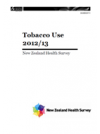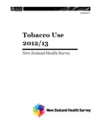The tobacco use report presents key findings from the New Zealand Health Survey 2012/13 about tobacco use. It provides a snapshot of tobacco use by adults over the age of 15 years, across different population groups (age, sex, ethnicity and neighbourhood deprivation). It presents information on when smokers smoked their first cigarette and how this has changed over time. Detailed data is also provided on who is quitting smoking and how they are quitting. Second-hand smoke exposure for adults and children is also presented in this report.
Key Results
The significant decrease in daily and current (daily, weekly and monthly) smoking in New Zealand seen since 1996/97 has continued.
- In 1996/97, a quarter (25%) of the adult population reported being current smokers and by 2012/13 this rate had dropped to 18%, equating to around 600,000 people.
- The decline in smoking prevalence is occurring at different rates among different population groups. For example, the 15–19 year olds showed the largest relative decline in current smoking prevalence (36%) between 2006/07 and 2012/13. In comparison, those aged 65–74 years and 25–34 years showed 27% and 13% relative declines respectively.
- Current smoking prevalence among Māori remains high and unchanged since 2006/07 at 39%.
- Pacific and Asian smoking prevalence has not changed at 25% and 10% respectively.
- The mean age of smoking initiation (when smokers tried their first cigarette) for current smokers aged 20 years and above was 14.8 years.
- Mean age of smoking initiation varied across all 4 main ethnic groups with Māori smokers being the youngest to start, at 14.1 years and Asian smokers the oldest, at 18.4 years.
- Most smokers surveyed had tried to quit smoking in the past 12 months with almost two-thirds (64%) quitting smoking for at least 24 hours and almost 6 out of 10 (58%) quitting smoking for at least a week.
- An estimated 82,000 recent quit attempters (11%) successfully quit smoking in 2012/13.
- The most common quitting product or service used by recent quit attempters was medicinal therapy, of which nicotine replacement therapy was the most used (25%).
- Half (50%) of all adults and approximately three-quarters (74%) of current smokers who had seen a General Practitioner (GP) in the previous 12 months reported that a GP had asked if they had ever been or currently were a smoker.
- The survey showed that 56% of current smokers who had seen a GP in the past 12 months were offered brief quitting advice (by the GP).
- Almost 7 out of 10 (68%) current smokers who had been admitted at least overnight at a public hospital in the past 12 months were provided with brief quitting advice and information with no differences detected by sex, age, ethnicity or neighbourhood deprivation.
- Around 4% of non-smoking adults were exposed to second-hand smoke (SHS) in the home, and 3% in the car they usually travelled in.
- Exposure to SHS both in the home and car was shown to be significantly higher in non-smokers who were younger, Māori and living in more deprived neighbourhoods. The 2012/13 prevalence (4%) of non-smoking adults’ exposure to SHS in the home had reduced by half compared to 2006/07 (8%).
- Children’s exposure to SHS in the home and car were similar at 6% and 5%, respectively.
- Māori children were 2.6 times more likely to be exposed to SHS in the home and car compared to non-Māori children.
- Compared to children living in the least deprived neighbourhoods, children living in the most deprived neighbourhoods were 7.8 times more likely to be exposed to SHS in the home and 3.9 times more likely to be exposed to SHS in the car.
- Almost a quarter (24%) of current smokers reported one or more diagnosed mental health conditions (depression, bipolar disorder, anxiety disorder, an alcohol-related disorder or a drug-related disorder) compared to 15% of non-smokers. Four out of 10 smokers (40%) who had drunk an alcoholic drink in the previous 12 months had a potentially hazardous drinking pattern, compared to 14% of non-smokers who had drunk an alcoholic drink.


